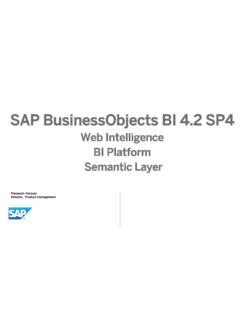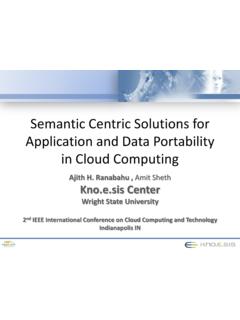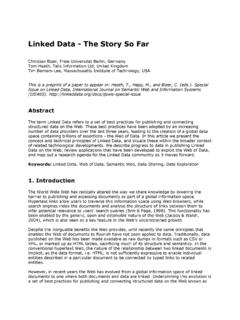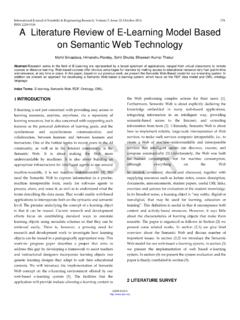Transcription of PixelLink: Detecting Scene Text via Instance Segmentation
1 pixellink : Detecting Scene Text via Instance SegmentationDan Deng1,3 ,Haifeng Liu1,Xuelong Li4,Deng Cai1,21 State Key Lab of CAD&CG, College of Computer Science, Zhejiang University2 Alibaba-Zhejiang University Joint Institute of Frontier Technologies3 CVTE Research4Xi an Institute of Optics and Precision Mechanics, Chinese Academy of state-of-the-art Scene text detection algorithms are deeplearning based methods that depend on bounding box regres-sion and perform at least two kinds of predictions: text/non-text classification and location regression. Regression plays akey role in the acquisition of bounding boxes in these meth-ods, but it is not indispensable because text/non-text predic-tion can also be considered as a kind of semantic segmenta-tion that contains full location information in itself.
2 However,text instances in Scene images often lie very close to eachother, making them very difficult to separate via semantic seg-mentation. Therefore, Instance Segmentation is needed to ad-dress this problem. In this paper, pixellink , a novel Scene textdetection algorithm based on Instance Segmentation , is pro-posed. Text instances are first segmented out by linking pixelswithin the same Instance together. Text bounding boxes arethen extracted directly from the Segmentation result withoutlocation regression. Experiments show that, compared withregression-based methods, pixellink can achieve better orcomparable performance on several benchmarks, while re-quiring many fewer training iterations and less training IntroductionReading text in the wild, or robust reading has drawn greatinterest for a long time (Ye and Doermann 2015).
3 It is usu-ally divided into two steps or sub-tasks: text detection andtext detection task, also called localization, takes an im-age as input and outputs the locations of text within it. Alongwith the advances in deep learning and general object detec-tion, more and more accurate as well as efficient Scene textdetection algorithms have been proposed, , CTPN (Tianet al. 2016), TextBoxes (Liao et al. 2017), SegLink (Shi, Bai,and Belongie 2017) and EAST (Zhou et al. 2017). Most ofthese state-of-the-art methods are built on Fully Convolu-tional Networks (Long, Shelhamer, and Darrell 2015), andperform at least two kinds of predictions:1. Text/non-text classification.
4 Such predictions can be takenas probabilities of pixels being within text bounding boxes(Zhang et al. 2016). But they are more frequently usedas confidences on regression results ( , TextBoxes,SegLink, EAST). Part of this work was done when Dan Deng was an intern atVisual Computing Group, CVTE segmentationoriginal imageFigure 1: Text instances often lie close to each other, makingthem hard to separate via semantic Location regression. Locations of text instances, or theirsegments/slices, are predicted as offsets from referenceboxes ( , TextBoxes, SegLink, CTPN), or absolute lo-cations of bounding boxes ( , EAST).In methods like SegLink, linkages between segments arealso predicted.
5 After these predictions, post-processing thatmainly includes joining segments together ( , SegLink,CTPN) or Non-Maximum Suppression ( , TextBoxes,EAST), is applied to obtain bounding boxes as the final regression has long been used in object detec-tion, as well as in text detection, and has proven to be effec-tive. It plays a key role in the formulation of text boundingboxes in state-of-the-art methods. However, as mentionedabove, text/non-text predictions can not only be used as theconfidences on regression results, but also as a segmentationscore map, which contains location information in itself andcan be used to obtain bounding boxes directly. Therefore,regression is not , as shown in Fig.
6 1, text instances in Scene im-ages usually lie very close to each other. In such cases, theyare very difficult, and are sometimes even impossible to sep-arate via semantic Segmentation ( , text/non-text predic-tion) only; therefore, Segmentation at the Instance level isfurther solve this problem, a novel Scene text detection algo-rithm, pixellink , is proposed in this paper. It extracts textlocations directly from an Instance Segmentation result, in-stead of from bounding box regression. In pixellink , a DeepNeural Network (DNN) is trained to do two kinds of pixel-wise predictions, text/non-text prediction, and link predic-tion. Pixels within text instances are labeled as positive ( ,text pixels), and otherwise are labeled as negative ( , non-text pixels).
7 The concept of link here is inspired by [ ] 4 Jan 2018link design in SegLink, but with significant difference. Ev-ery pixel has 8 neighbors. For a given pixel and one of itsneighbors, if they lie within the same Instance , the link be-tween them is labeled as positive, and otherwise positive pixels are joined together into ConnectedComponents (CC) by predicted positive links. Instance seg-mentation is achieved in this way, with each CC representinga detected text. Methods likeminAreaRectin OpenCV (Its2014) can be applied to obtain the bounding boxes of CCsas the final detection experiments demonstrate the advantages of PixelLinkover state-of-the-art methods based on regression.
8 Specif-ically, trained from scratch, pixellink models can achievecomparable or better performance on several benchmarkswhile requiring fewer training iterations and less Related Semantic& Instance SegmentationThe Segmentation task is to assigning pixel-wise labels toan image. When only object category is considered, it iscalled semantic Segmentation . Dominating methods for thistask usually adopts the approach of Fully Convolution Net-works (FCN) (Long, Shelhamer, and Darrell 2015). Instancesegmentation is more challenging than semantic segmenta-tion because it requires not only object category for eachpixel but also a differentiation of instances.
9 It s more rele-vant to general object detection than semantic Segmentation ,for being aware of object instances. Recent methods in thisfield make heavy use of object detection systems. FCIS (Liet al. 2016) extends the idea of position-sensitive predictionin R-FCN (Dai et al. 2016). Mask R-CNN (He et al. 2017a)changes the RoIPooling in Faster R-CNN (Ren et al. 2015)to RoIAlign. They both do detection and Segmentation in asame deep model, and highly depend their Segmentation re-sults on detection Segmentation -based Text DetectionSegmentation has been adopted in text detection for a longtime. (Yao et al. 2016) cast the detection task as a seman-tic Segmentation problem, by predicting three kinds of scoremaps: text/non-text, character classes, and character linkingorientations.
10 They are then grouped into words or lines. In(Zhang et al. 2016), TextBlocks are found from a saliencymap predicted by FCN, and character candidates are ex-tracted using MSER (Donoser and Bischof 2006). Linesor words are formed using hand-crafted rules at last. InCCTN (He et al. 2016), a coarse network is used to detecttext regions roughly by generating a text region heat-map,and then the detected regions are refined into text lines by afine text network, which outputs a central line area heat-mapand a text line area heat-map. These methods often sufferfrom time-consuming post-processing steps and unsatisfy-ing Regression-based Text DetectionMost methods in this category take advantage of the de-velopment in general object detection.
![arXiv:0706.3639v1 [cs.AI] 25 Jun 2007](/cache/preview/4/1/3/9/3/1/4/b/thumb-4139314b93ef86b7b4c2d05ebcc88e46.jpg)

![arXiv:1301.3781v3 [cs.CL] 7 Sep 2013](/cache/preview/4/d/5/0/4/3/4/0/thumb-4d504340120163c0bdf3f4678d8d217f.jpg)
![@google.com arXiv:1609.03499v2 [cs.SD] 19 Sep 2016](/cache/preview/c/3/4/9/4/6/9/b/thumb-c349469b499107d21e221f2ac908f8b2.jpg)












